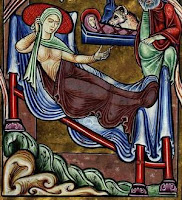Some pictures of 12th C beds, for Amalie, who made almost exactly the tent I want, so I'm hoping she'll make the bed I want and then I can find someone to make a copy of her prototype :-). The other pictures of people sleeping show what may be simple pallets on the ground, people just wrapped in cloaks of blankets, pictures which smudge out the details of what they are lying on, and people lying on beds that look like slabs with no upright features. These depictions of beds are all fairly similar in construction, and look lightweight enough to use for camping, indeed one is shown in a tent below. Notice how these beds often double as couches.
Bede "Life of St. Cuthbert" (British Library Yates Thompson 26)
Durham; last quarter of 12th century
Images online here and there, with lots of beds in it.
f21. The dying Boisil instructs St. Cuthbert, and prophesies things which were to come to him.
f.80 A paralytic is healed by contact with one of St. Cuthbert's shoes
f61. A sick man is healed with bread which St. Cuthbert had blessed
f33v. St. Cuthbert drives out a devil from the wife of Hildmaer, a prefect of King Ecgfrid
f54. After St. Cuthbert's election to the bishopric, an earl's servant is cured by water blessed by the saint
f58v. The wife of an earl is cured, after a monk sprinkles her with holy water sent by St. Cuthbert
Admont Bible (Österreichische Nationalbibliothek, Wien. Cod. ser. nov. 2701)
Salzberg early 12th C
I've rambled about this manuscript before.
f18. The story of Hoshea
Copenhagen Psalter (Kongelige Bibliotek Thott 143 2º)
England, 1175-1200.
f9v Nativity Aberdeen Bestiary (Aberdeen University Library MS 24)
Aberdeen Bestiary (Aberdeen University Library MS 24)
England around 1200
f57r The Caladrius looks at a sick person, takes the illness upon itself and flies away with the disease to the sun. 
Skylitz chonicles (Biblioteca Nacional, Madrid Bibl. Nac. vitr. 26-2)
mid-12th mid-13th century, 
Winchester psalter (British Library MS Cotton Nero C.IV)
c1145-1155
f 29. The Death of the Virgin
Worchester Chronicle (Oxford, Corpus Christi Library, MS 157)
Worchester Cathedral Priory, England, c1130-40
The Visions of Henry I in Normandy
Monday, 23 February 2009
Pictures of Beds - 12th Century of course!
comming live to you at
10:30 pm
Subscribe to:
Post Comments (Atom)










9 comments:
Ooo beds! Thank you! I will send you the plans for the tent soon- we have misplaced the original plans so will have to measure the actual tent...
My pleasure. I've a few more pictures of beds to sort, but there's nothing particularly different to this lot.
Have you seen this article on making "period" ish (I don't know if its exactly the same period, but it seems to me some of those pictures could be similar rope beds, and some probably aren't. (Or could be with a mattress on top.)?
http://www.daviddfriedman.com/Medieval/Articles/rope_bed/rope_bed.htm
I hadn't seen the article, but I have seen the picture. I was waiting to find my copy of the picture and try to sort out the 8/9th C vs 13th C date conundrum (art historians give wildly differing dates for it in different sources) and post it in part 2 of beds.
A friend has interpreted that picture as a sprang rope meshing. Because the dowel is utterly integral to sprang. I'm facinated by her sprang beds, and so want to try my own. But on looking at the picture again, I'm not sure if the picture supports it. I think the sprang bed does look more comfortable and simpler to thread than the normal rope bead threading patterns - dependant on being able to do sprang of course.
ps. thanks for thelink!
The Aberdeen Bestiary Caladrius image of about 1190 is indeed significant on several counts.
The Anglo-Norman word couche meant both a bed and a couch for sitting - this is clearly a good example of such a dual-purpose piece. Coutes were thin, padded mattresses which could serve as seats and were placed on top of the main feather-stuffed mattress.
Alexander Neckham's description of an aristocratic bedchamber mentions that "A perch should be nearby [the bed] on which can rest a hawk . . . From another pole let there hang clothing." Here the mythical Caladrius bird replaces the hunting hawk. (Neckham: De Nominibus Utensilium, circa 1180).
Oh, thanks for the text from Neckam. This is exactly the kind of bed I'd love to have, so it's great to have more references to how they are used and confirmation that poles are for hanging clothing on.
I really enjoyed your blog thanks for sharing.
\zsdc
Post a Comment